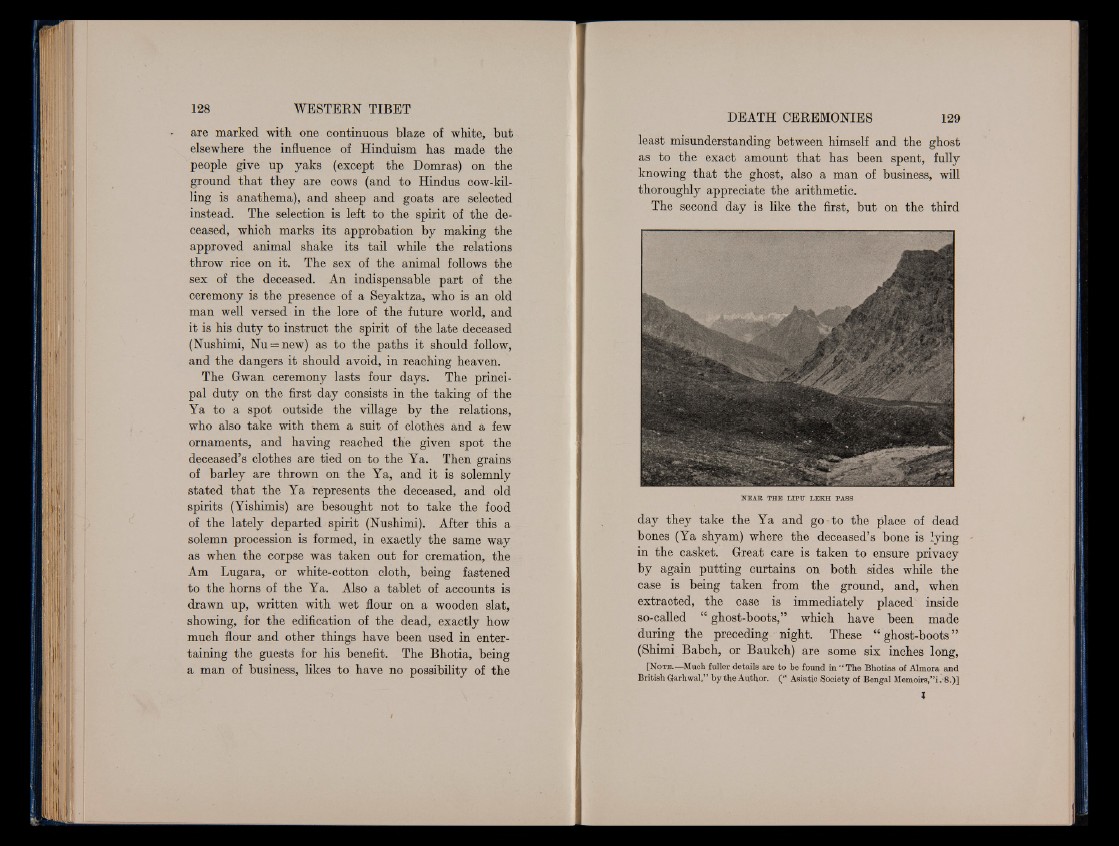
are marked with one continuous blaze of white, but
elsewhere the influence of Hinduism has made the
people give up yaks (except the Domras) on the
ground that they are cows (and to Hindus cow-killing
is anathema), and sheep and goats are selected
instead. The selection is left to the spirit of the deceased,
which marks its approbation by making the
approved animal shake its tail while the relations
throw rice on it. The sex of the animal follows the
sex of the deceased. An indispensable part of the
ceremony is the presence of a Seyaktza, who is an old
man well versed in the lore of the future world, and
it is his duty to instruct the spirit of the late deceased
(Nushimi, Nu = new) as to the paths it should follow,
and the dangers it should avoid, in reaching heaven.
The Gwan ceremony lasts four days. The principal
duty on the first day consists in the taking of the
Ya to a spot outside the village by the relations,
who also take with them a suit of clothes and a few
ornaments, and having reached the given spot the
deceased’s clothes are tied on to the Ya. Then grains
of barley are thrown on the Ya, and it is solemnly
stated that the Ya represents the deceased, and old
spirits (Yishimis) are besought not to take the food
of the lately departed spirit (Nushimi). After this a
solemn procession is formed, in exactly the same way
as when the corpse was taken out for cremation, the
Am Lugara, or white-cotton cloth, being fastened
to the horns of the Ya. Also a tablet of accounts is
drawn up, written with wet flour on a wooden slat,
showing, for the edification of the dead, exactly how
much flour and other things have been used in entertaining
the guests for his benefit. The Bhotia, being
a man of business, likes to have no possibility of the
least misunderstanding between himself and the ghost
as to the exact amount that has been spent, fully
knowing that the ghost, also a man of business, will
thoroughly appreciate the arithmetic.
The second day is like the first, but on the third
NEAR THE LIPU LEKH PASS
day they take the Ya and go-to the place of dead
bones (Ya shyam) where the deceased’s bone is lying
in the casket. Great care is taken to ensure privacy
by again putting curtains on both sides while the
case is being taken from the ground, and, when
extracted, the case is immediately placed inside
so-called “ ghost-boots,” which have been made
during the preceding night. These “ ghost-boots ”
(Shimi Babch, or Baukch) are some six inches long,
[N o t e.—Much fuller details are to be found in “ The Bhotias of Almora and
British Garhwal,” by the Author. ( “ Asiatic Society of Bengal Memoirs,”i .-8.)]
X